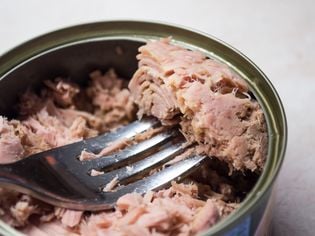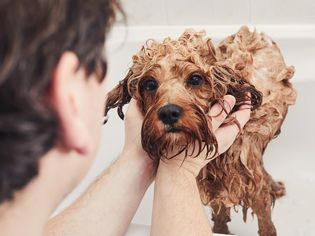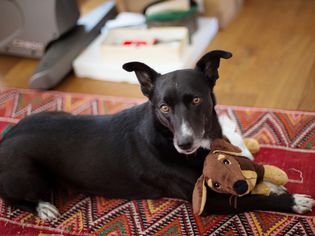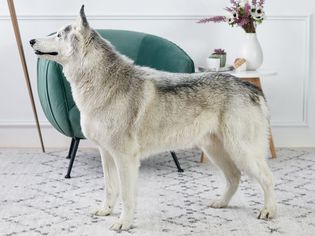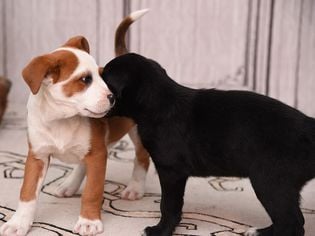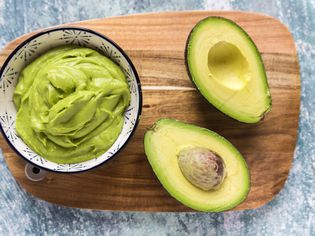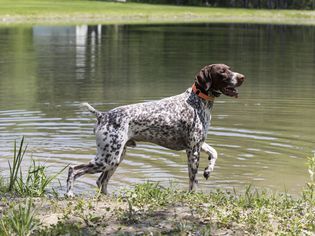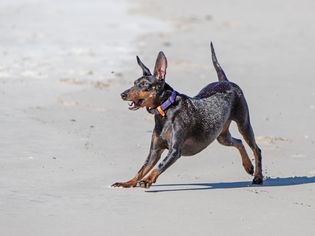The Scottish deerhound is a large dog breed from Scotland with a long and lean physique much like a greyhound. Among the tallest of all dog breeds, they’re athletic, affectionate, and loyal companions who make delightful family pets.
If this beautiful breed has caught your eye, read on to learn about the appearance, temperament, care, and history of the Scottish deerhound.
Breed Overview
GROUP: Hound
HEIGHT: 30 to 32 inches (males); 28 inches and up (females)
WEIGHT: 85 to 110 pounds (males); 75 to 95 pounds (females)
COAT: Wiry
COAT COLOR: Varying shades of gray, fawn, or brindle
LIFE SPAN: 8 to 11 years
TEMPERAMENT: Dignified, docile, gentle, friendly
HYPOALLERGENIC: No
ORIGIN: Scotland
Characteristics of the Scottish Deerhound
Scottish deerhounds are very loyal and extremely affectionate with their families and typically prefer not to be left alone. With a friendly temperament, this breed is rarely aggressive and responds well to strangers. This is definitely not a guard dog.
| Affection Level | High |
| Friendliness | High |
| Kid-Friendly | Medium |
| Pet-Friendly | Low |
| Exercise Needs | High |
| Playfulness | High |
| Energy Level | Medium |
| Trainability | Medium |
| Intelligence | Medium |
| Tendency to Bark | Low |
| Amount of Shedding | Low |
History of the Scottish Deerhound
The Scottish deerhound can be traced back to 16th century Scotland but likely existed earlier, going by several names, including the Irish wolf dog, Scotch greyhound, rough greyhound, and Highland deerhound. Ultimately, the breed was named for their skillful ability to hunt deer.
The Scottish deerhound has been prized for their skill and beauty. During the Age of Chivalry, no one ranking lower than an earl was allowed to have a deerhound. Despite this, the breed faced near-extinction in the mid to late 18th century—with the collapse of the Scottish nobility after the battle of Culloden and the Jacobite rebellion—but was saved by enthusiasts Archibald and Duncan McNeill. The breed again became rare after World War I due to the breakup of large estates.
The Scottish deerhound arrived in the United States towards the end of the 19th century and was admitted to the American Kennel Club (AKC) Hound group in 1886. Today, the deerhound remains a relatively rare breed of high value.

Peter Rae / Fairfax Media Archives / Contributor / Getty Images
Scottish Deerhound Care
The Scottish deerhound is not especially difficult to care for, provided you have the space to accommodate a large dog. They're friendly, moderately active, and can get along with many types of families, including those with older children. Due to their size, these dogs may accidentally knock over younger kids, so use caution and teach children how to behave around dogs.
Exercise
Though Scottish deerhounds are excellent athletes, they can also become lazy as adults. They love to run and play outdoors but might loaf around when indoors. However, daily exercise of at least two full hours is essential to keep your deerhound motivated and fit. Besides walks, try hiking, jogging, cycling, tug-of-war, and endless games of fetch to wear your deerhound out.
You will need to walk your deerhound on a leash as this breed will chase anything that moves. This can also be a challenge as they will bolt when on a leash and could yank you off your feet due to their size.
Grooming
The Scottish deerhound has a harsh and wiry coat that is 3 to 4 inches long and requires only basic grooming. A weekly once-over with a slicker brush and/or comb should be sufficient to keep the deerhound's coat looking its best. The breed sheds at a fairly low rate, and even less with regular brushing. Your deerhound should only need occasional bathing as necessary based on odor or a dirty coat.
Training
Proper training and socialization are important for deerhounds. Fortunately, they tend to learn well. This is an intelligent breed but often has a short attention span. In training, it is important to discover what motivates your deerhound, as this can be a challenge for some.
Other Pets
Like other sighthounds, the deerhound is easily stimulated by visual prey because of its high prey drive. Cats and other small animals may provoke their predatory instinct until they learn the animal is a family member. Raising your deerhound around small pets can help teach the dog that they are not prey. However, you might never feel comfortable leaving your deerhound unsupervised around small pets. They enjoy the company of other large dogs, especially other deerhounds.
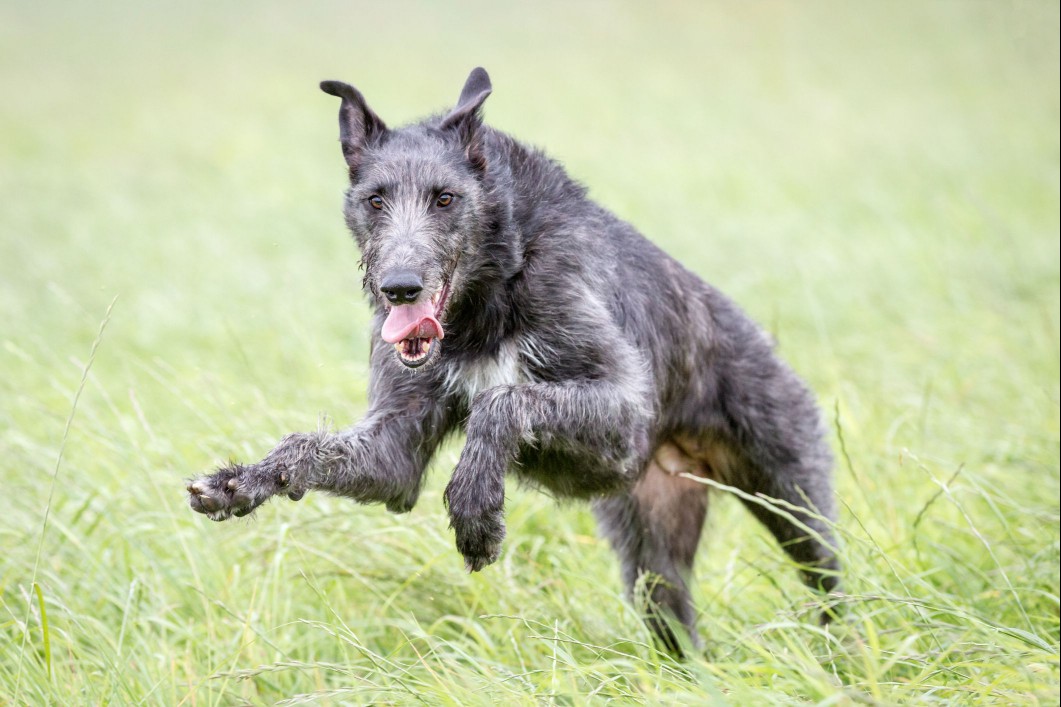
Common Health Problems
Responsible breeders strive to maintain the highest breed standards as established by kennel clubs like the AKC. Dogs bred by these standards are less likely to inherit health conditions. However, some hereditary health problems can occur in the breed. The following are some conditions to be aware of:
- Anesthesia Sensitivity: A regular dose of anesthesia cannot be given to this breed when it undergoes a procedure.
- Dilated Cardiomyopathy: An enlarged heart can lead to abnormal rhythms and heart failure.
- Osteosarcoma: These aggressive bone tumors may require amputation and chemotherapy.
- Factor VII Deficiency: This is an inherited mild to moderate condition may result in the lack of a blood clotting factor which increases bleeding.
- Cystinuria: This condition causes the formation of kidney and bladder stones.
- Hip Dysplasia: This orthopedic condition results in an abnormal development of the hip joints.
- Gastric Dilatation-Volvulus (Bloat): The life-threatening condition causes bloating and stomach torsion.
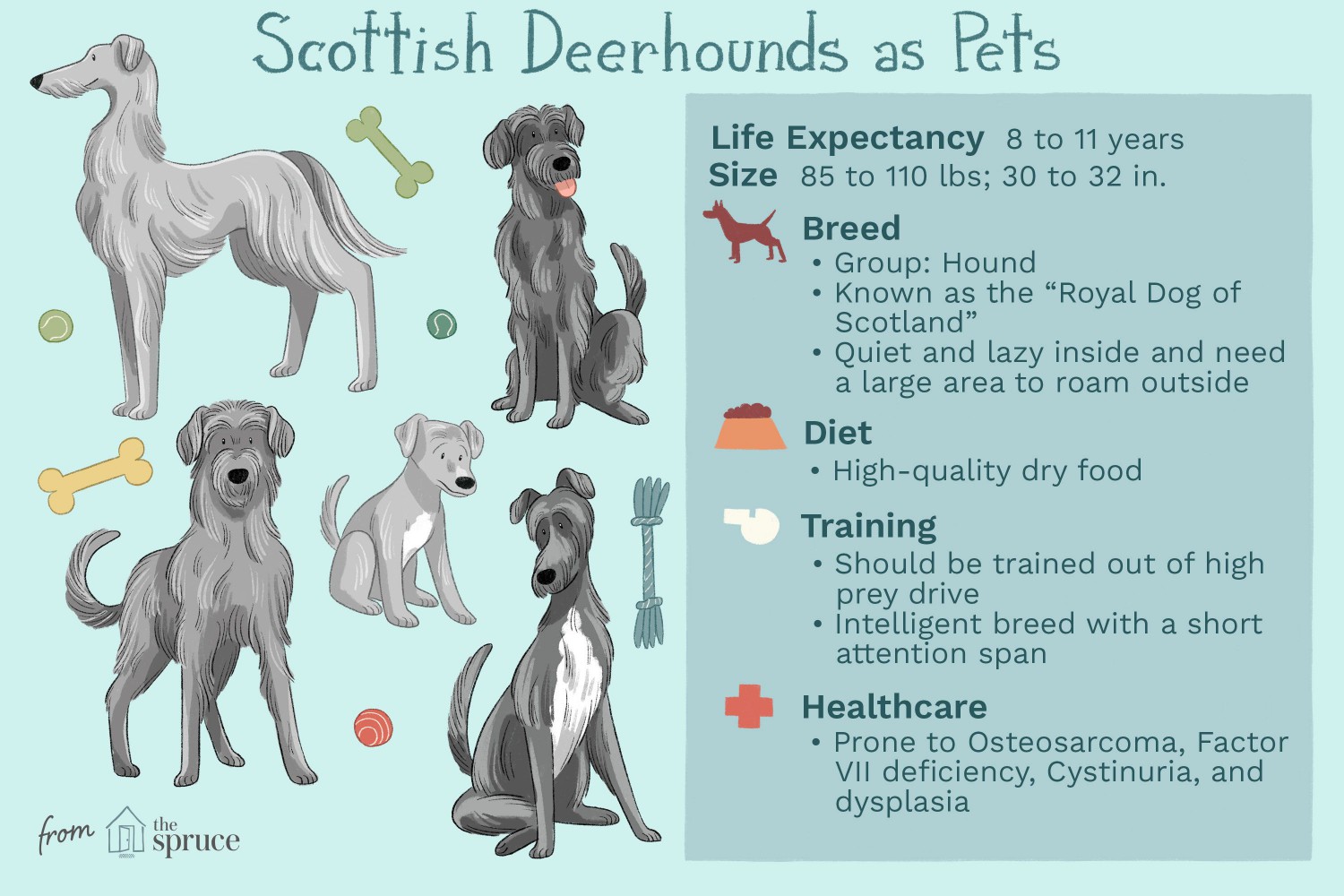
The Spruce / Kelly Miller
Diet and Nutrition
Most Scottish deerhounds need about three to four cups of dry food each day, which should be divided into two meals. The exact amount fed will depend on the brand, calorie content, and the dog’s size and activity level.
Deerhounds are prone to bloating, especially if they gulp their food or eat too much at one time. When a bloated stomach becomes twisted, it is a medical emergency.
Monitor your dog's weight to prevent obesity. A dog's needs will change as it ages and you should discuss appropriate feeding schedules, amount of food, type of food, and exercise with your veterinarian.
Where to Adopt or Buy a Scottish Deerhound
A Scottish deerhound may be tough to find, so locating a puppy or rescue may take some time. If you find a breeder, expect to pay between $1,000 to $2,500 for a puppy depending on its lineage. Start your search using these resources:
- The Scottish Deerhound Club of America: Offers information about rescues and placement, as well as maintains lists of reputable breeders throughout the U.S. and Canada.
- AKC Marketplace
Scottish Deerhound Overview
Gentle and playful
Affectionate
Friendly
Tends to pull or bolt very hard when on a leash
High prey drive
Tends to become lazy
More Dog Breeds and Further Research
Before you decide whether a Scottish deerhound is right for you, be sure to do plenty of research. Talk to other Scottish deerhound owners, reputable breeders, and rescue groups to learn more.
If you’re interested in similar breeds, look to these to compare pros and cons.
- Irish wolfhound
- Greyhound
- Whippet
- Redbone coonhound
There are many dog breeds to explore. With a little research, you can find the right one to bring home.
- Is the Scottish deerhound a good apartment dog?
Even though deerhounds are quiet and lazy indoors, and they seem like apartment dwellers, the fact is that they're not well-suited to apartment living. These large dogs need a yard and room to roam daily. Yards need to be securely fenced as they will try to pursue anything moving outside the fence—electronic fences will not stop these athletes.
Are Scottish deerhounds a good dog for children?Most deerhounds will do well with children when properly socialized. But as a large dog, it should not be left unsupervised around small children. Children should not walk a Scottish deerhound because of its propensity to assertively pull and bolt while walking on a leash.
Why are Scottish deerhounds so rare in the U.S.?Most deerhounds are rare, both here and in Scotland. One reason the breed is rare in the U.S. is that this country doesn't allow the hunting of antlered game using dogs. The breed has a very small gene pool and few breeders, making this a prized dog.
Is a Scottish Deerhound bigger than an Irish wolfhound?Although the breeds share a similar appearance, the Irish wolfhound is taller and more muscular than the Scottish deerhound. You can tell these two breeds apart by their ears and tails—Irish wolfhounds have smaller, greyhound-like ears and slightly curved tails while Scottish deerhounds have high, folded-back ears and tapered tails that nearly reach the ground.
10 Best Dog Breeds for Runners

